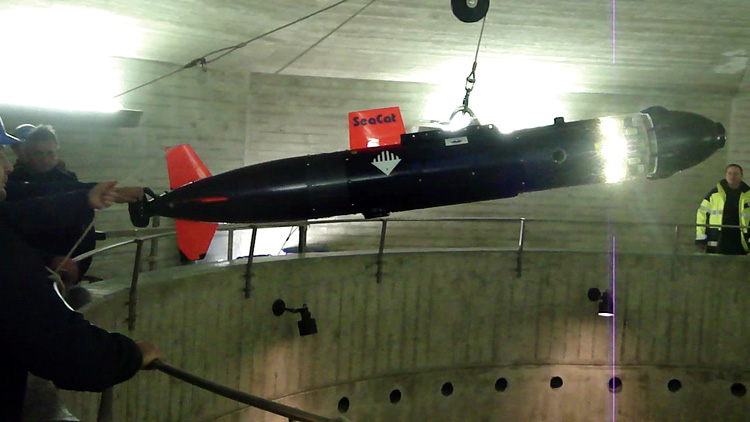- Prime Minister Narendra Modi inaugurates Aero India 2023 in Bengaluru; Releases Commemorative Stamp
- Defence Secretary meets delegations from Saudi Arabia, USA and Oman on the sidelines of Aero India 2023
- Foreign Ministers of 32 countries to attend Aero India 2023
- Embraer showcases the C-390 Millennium at Aero India 2023
SeaCat inspects drinking water tunnel

In a mission lasting almost seven hours, an autonomous underwater vehicle made by Atlas Elektronik “dived” through a water supply tunnel 24 kilometres long in the vicinity of Stuttgart, successfully investigating the tunnel for damage. With this survey on March 6, 2012, it at last became possible to inspect the “Albstollen” tunnel in the state of Baden-Württemberg for the first time in 40 years.
The “SeaCat” underwater vehicle is produced by the Bremen-based company Atlas Elektronik, a world leading manufacturer of marine electronics, such as sonars, submarine technology, mine warfare systems and unmanned underwater vehicles (UUVs).
After a thorough disinfection, the craft was lowered into the inflow reservoir at Büttnau and guided into the tunnel by remote control. For the first 300 metres, the SeaCat was controlled through a laptop via a fibre-optic cable. After the vehicle had passed several obstacles in the first section, the cable was cut and the autonomous guidance system was activated to take control for the next seven hours and 24 kilometres. The speed was about a metre per second, corresponding about two knots or 3.6 kmph.
Sven Hesse, head of the UUV programme at Atlas, said after the mission: “Never before has a water-filled tunnel of this length been inspected by a diving robot navigating on its own. And rarely has such an entirely autonomous vehicle completed such a demanding task.” Volker Paltzo and Dieter Rottsieper, Managing Directors of Atlas Elektronik, commented: “We can certainly be proud of this achievement. It proves that Atlas Elektronik is right on course to carve out a world leading role in this new field of technology.” The “Albstollen” tunnel, with a length of 24 kilometres and a diameter von 2.25 metres, forms part of the water supply system operated by Bodensee-Wasserversorgung (BWV) with headquarters in Stuttgart. As the largest German long-distance water distribution systems, it provides fresh water from Lake Constance to four million people in 320 communities. As one of two main lines, the Albstollen passes through the Swabian Jura range to supply Stuttgart and the northern part of Baden-Württemberg.
The vehicle was tasked with recording video data over the total length of the tunnel, while moving continuously through the concrete tunnel and remaining centred with the aid of laser distance sensors. For the first time in 40 years, it became possible to look deep into the tunnel and to document its present condition.
The exit point of the trip after 24 kilometres was the shaft surge chamber at Talheim, a concrete structure comprising a shaft 38 metres deep and about eight metres in diameter. This pressure-balancing well is normally half-filled with water. The water tunnel is routed through the well, forming a semi-circular channel at the bottom. A diver’s lamp was positioned at this point to provide a light indicating that the AUV had reached its final destination. This visual signal was detected by the vehicle, causing the autonomous guidance system to stop the vehicle and let it rise to the surface.
This pioneering accomplishment was made possible by outstanding teamwork between the staff of BWV and of Atlas Elektronik. While the mission demonstrated the technical reliability of the SeaCat, it also showed that the water tunnel was still in good condition after 40 years of continuous use.
The SeaCat AUV is a torpedo-shaped underwater vehicle about 2.5 m in length and 30 cm in diameter. Being a hybrid vehicle, it can be operated either remotely controlled or fully autonomously with an endurance of up to eight hours and a range of 40 km. Video cameras and a variety of sonars can be carried as the payload sensors. Typical areas of application include the inspection and mapping of inshore lakes, coastal sea areas, harbours, and marine structures such as dams or the foundations of wind turbines.





